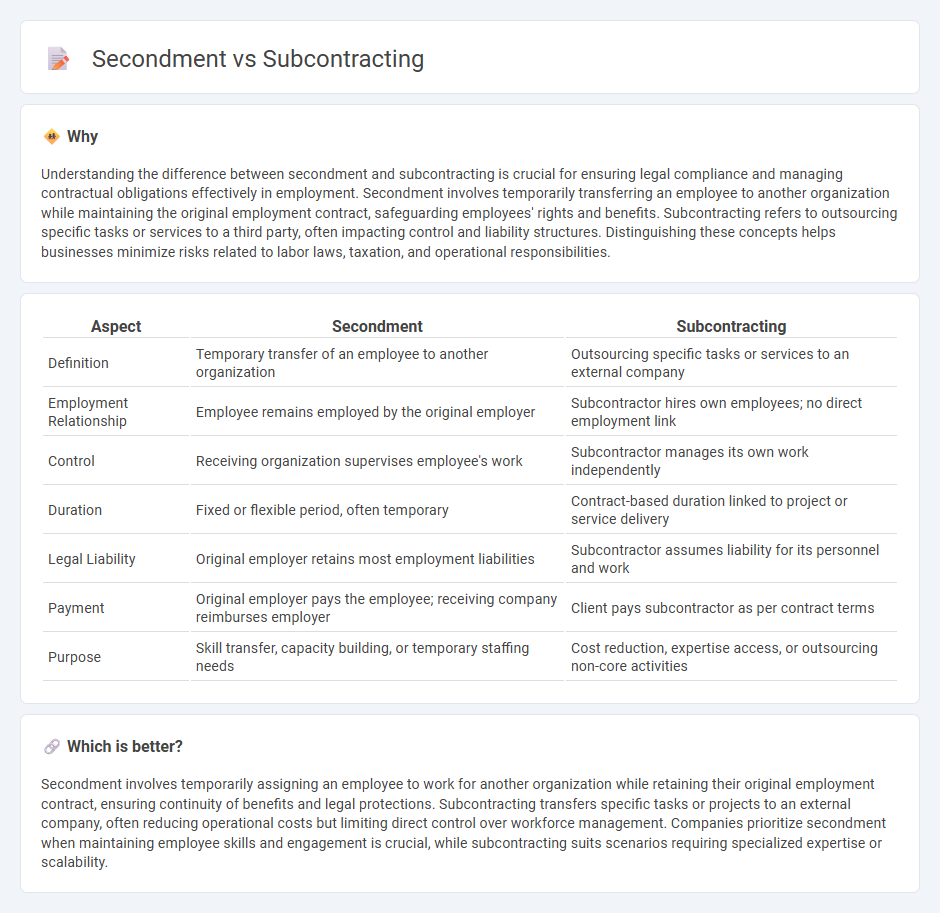
Secondment involves temporarily assigning employees to work within another organization while retaining their original employment status and benefits, fostering deeper integration and knowledge transfer. Subcontracting refers to outsourcing specific tasks or projects to external companies or individuals, often to reduce costs and increase flexibility without changing the core workforce. Explore the detailed differences between secondment and subcontracting to optimize your workforce strategy.
Why it is important
Understanding the difference between secondment and subcontracting is crucial for ensuring legal compliance and managing contractual obligations effectively in employment. Secondment involves temporarily transferring an employee to another organization while maintaining the original employment contract, safeguarding employees' rights and benefits. Subcontracting refers to outsourcing specific tasks or services to a third party, often impacting control and liability structures. Distinguishing these concepts helps businesses minimize risks related to labor laws, taxation, and operational responsibilities.
Comparison Table
| Aspect | Secondment | Subcontracting |
|---|---|---|
| Definition | Temporary transfer of an employee to another organization | Outsourcing specific tasks or services to an external company |
| Employment Relationship | Employee remains employed by the original employer | Subcontractor hires own employees; no direct employment link |
| Control | Receiving organization supervises employee's work | Subcontractor manages its own work independently |
| Duration | Fixed or flexible period, often temporary | Contract-based duration linked to project or service delivery |
| Legal Liability | Original employer retains most employment liabilities | Subcontractor assumes liability for its personnel and work |
| Payment | Original employer pays the employee; receiving company reimburses employer | Client pays subcontractor as per contract terms |
| Purpose | Skill transfer, capacity building, or temporary staffing needs | Cost reduction, expertise access, or outsourcing non-core activities |
Which is better?
Secondment involves temporarily assigning an employee to work for another organization while retaining their original employment contract, ensuring continuity of benefits and legal protections. Subcontracting transfers specific tasks or projects to an external company, often reducing operational costs but limiting direct control over workforce management. Companies prioritize secondment when maintaining employee skills and engagement is crucial, while subcontracting suits scenarios requiring specialized expertise or scalability.
Connection
Secondment and subcontracting both involve temporary shifts in workforce allocation to meet organizational needs, with secondment typically referring to the temporary transfer of an employee within or between organizations while maintaining their original employment contract. Subcontracting involves delegating specific tasks or projects to an external entity, allowing companies to optimize resources and reduce costs without expanding their permanent workforce. Both practices enhance operational flexibility and workforce scalability by leveraging external or internal talent for specialized or short-term requirements.
Key Terms
Contractual Relationship
Subcontracting involves a contractual agreement where a primary contractor hires an external party to perform specific tasks or services, maintaining a clear distinction in roles and responsibilities. Secondment refers to the temporary transfer of an employee from one company to another while retaining the original employment contract, ensuring continuous employment rights and obligations. Explore further to understand the nuances and legal implications of these distinct contractual relationships.
Control and Supervision
Subcontracting involves a third-party entity performing work while maintaining a degree of control and supervision by the primary contractor, ensuring contract compliance and quality standards. Secondment transfers an employee temporarily to another organization, where the host exercises direct control and supervision over daily tasks and work conditions. Explore the differences in control and supervision frameworks to optimize workforce management strategies effectively.
Legal Employer
Subcontracting involves an external company providing services while retaining legal employer responsibilities for its employees, whereas secondment temporarily transfers employees to another organization that assumes legal employer duties. The legal employer remains responsible for employment contracts, social security, and compliance in subcontracting, contrasting with secondment where these responsibilities shift during the assignment period. Explore in-depth legal frameworks and case studies to understand the distinctions fully.
Source and External Links
What is Subcontracting? Definition & Best Practices - Deltek - Subcontracting involves smaller or specialized businesses working under prime contractors who contract directly with the government, handling specific tasks within a larger government contract.
Prime and subcontracting | U.S. Small Business Administration - Subcontractors work for prime contractors rather than directly with the government, often under small business subcontracting plans that ensure federal prime contractors subcontract portions to small or disadvantaged businesses.
Subcontractor - Wikipedia - A subcontractor is a person or business that performs part or all of the obligations under another's contract, often governed by contract and tax laws, and may be named during bidding in construction and other industries.
 dowidth.com
dowidth.com